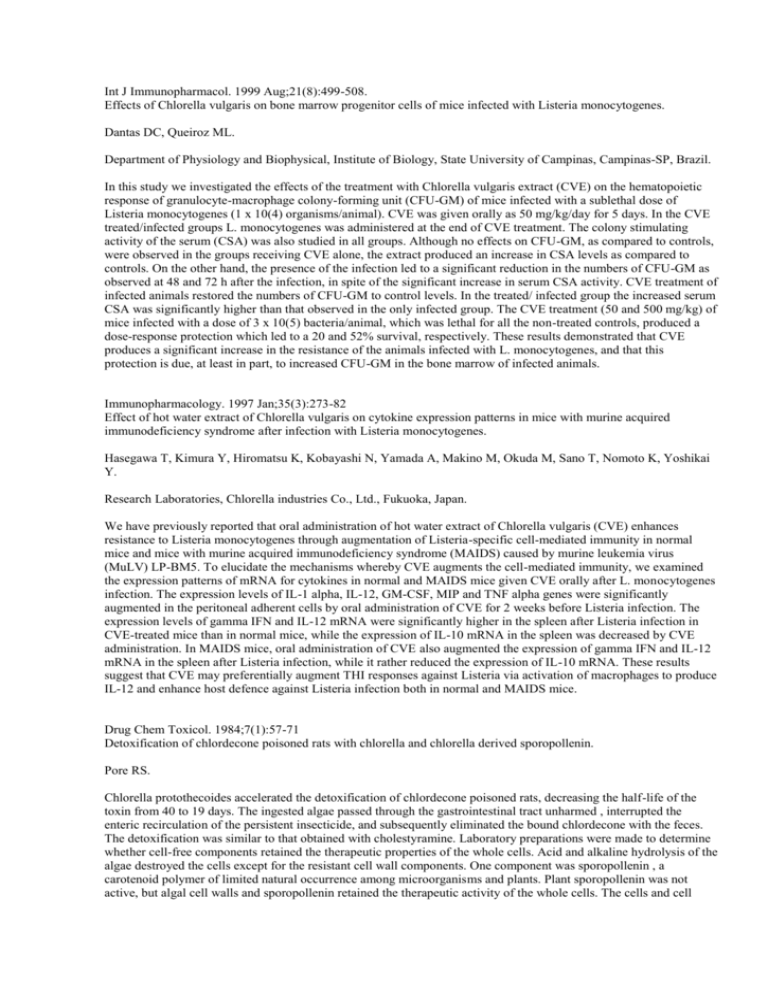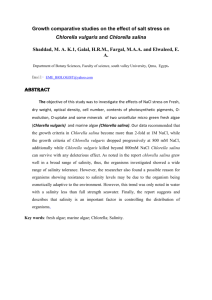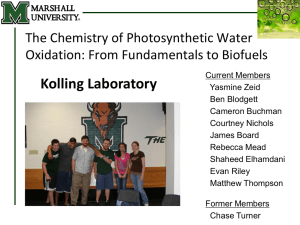Int J Immunopharmacol
advertisement

Int J Immunopharmacol. 1999 Aug;21(8):499-508. Effects of Chlorella vulgaris on bone marrow progenitor cells of mice infected with Listeria monocytogenes. Dantas DC, Queiroz ML. Department of Physiology and Biophysical, Institute of Biology, State University of Campinas, Campinas-SP, Brazil. In this study we investigated the effects of the treatment with Chlorella vulgaris extract (CVE) on the hematopoietic response of granulocyte-macrophage colony-forming unit (CFU-GM) of mice infected with a sublethal dose of Listeria monocytogenes (1 x 10(4) organisms/animal). CVE was given orally as 50 mg/kg/day for 5 days. In the CVE treated/infected groups L. monocytogenes was administered at the end of CVE treatment. The colony stimulating activity of the serum (CSA) was also studied in all groups. Although no effects on CFU-GM, as compared to controls, were observed in the groups receiving CVE alone, the extract produced an increase in CSA levels as compared to controls. On the other hand, the presence of the infection led to a significant reduction in the numbers of CFU-GM as observed at 48 and 72 h after the infection, in spite of the significant increase in serum CSA activity. CVE treatment of infected animals restored the numbers of CFU-GM to control levels. In the treated/ infected group the increased serum CSA was significantly higher than that observed in the only infected group. The CVE treatment (50 and 500 mg/kg) of mice infected with a dose of 3 x 10(5) bacteria/animal, which was lethal for all the non-treated controls, produced a dose-response protection which led to a 20 and 52% survival, respectively. These results demonstrated that CVE produces a significant increase in the resistance of the animals infected with L. monocytogenes, and that this protection is due, at least in part, to increased CFU-GM in the bone marrow of infected animals. Immunopharmacology. 1997 Jan;35(3):273-82 Effect of hot water extract of Chlorella vulgaris on cytokine expression patterns in mice with murine acquired immunodeficiency syndrome after infection with Listeria monocytogenes. Hasegawa T, Kimura Y, Hiromatsu K, Kobayashi N, Yamada A, Makino M, Okuda M, Sano T, Nomoto K, Yoshikai Y. Research Laboratories, Chlorella industries Co., Ltd., Fukuoka, Japan. We have previously reported that oral administration of hot water extract of Chlorella vulgaris (CVE) enhances resistance to Listeria monocytogenes through augmentation of Listeria-specific cell-mediated immunity in normal mice and mice with murine acquired immunodeficiency syndrome (MAIDS) caused by murine leukemia virus (MuLV) LP-BM5. To elucidate the mechanisms whereby CVE augments the cell-mediated immunity, we examined the expression patterns of mRNA for cytokines in normal and MAIDS mice given CVE orally after L. monocytogenes infection. The expression levels of IL-1 alpha, IL-12, GM-CSF, MIP and TNF alpha genes were significantly augmented in the peritoneal adherent cells by oral administration of CVE for 2 weeks before Listeria infection. The expression levels of gamma IFN and IL-12 mRNA were significantly higher in the spleen after Listeria infection in CVE-treated mice than in normal mice, while the expression of IL-10 mRNA in the spleen was decreased by CVE administration. In MAIDS mice, oral administration of CVE also augmented the expression of gamma IFN and IL-12 mRNA in the spleen after Listeria infection, while it rather reduced the expression of IL-10 mRNA. These results suggest that CVE may preferentially augment THI responses against Listeria via activation of macrophages to produce IL-12 and enhance host defence against Listeria infection both in normal and MAIDS mice. Drug Chem Toxicol. 1984;7(1):57-71 Detoxification of chlordecone poisoned rats with chlorella and chlorella derived sporopollenin. Pore RS. Chlorella protothecoides accelerated the detoxification of chlordecone poisoned rats, decreasing the half-life of the toxin from 40 to 19 days. The ingested algae passed through the gastrointestinal tract unharmed , interrupted the enteric recirculation of the persistent insecticide, and subsequently eliminated the bound chlordecone with the feces. The detoxification was similar to that obtained with cholestyramine. Laboratory preparations were made to determine whether cell-free components retained the therapeutic properties of the whole cells. Acid and alkaline hydrolysis of the algae destroyed the cells except for the resistant cell wall components. One component was sporopollenin , a carotenoid polymer of limited natural occurrence among microorganisms and plants. Plant sporopollenin was not active, but algal cell walls and sporopollenin retained the therapeutic activity of the whole cells. The cells and cell walls have potential as detoxifying drugs for animals poisoned by chlordecone and other xenobiotic compounds with similar properties. Planta Med. 2001 Nov;67(8):737-42. Isolation of three high molecular weight polysaccharide preparations with potent immunostimulatory activity from Spirulina platensis, aphanizomenon flos-aquae and Chlorella pyrenoidosa. Pugh N, Ross SA, ElSohly HN, ElSohly MA, Pasco DS. Department of Pharmacognosy, School of Pharmacy, University of Mississippi, University, Mississippi 38677, USA. This research describes the identification of three new high molecular weight polysaccharide preparations isolated from food-grade microalgae that are potent activators of human monocytes/macrophages: "Immulina" from Spirulina platensis, "Immunon" from Aphanizomenon flos-aquae, and "Immurella" from Chlorella pyrenoidosa. These polysaccharides are structurally complex and have estimated molecular weights above ten million daltons. All three polysaccharides are highly water soluble and comprise between 0.5 % and 2.0 % of microalgal dry weight.Immunostimulatory activity was measured using a transcription factor-based bioassay for nuclear factor kappa B (NF-kappa B) activation in THP-1 human monocytes/macrophages. Using this system the EC(50) values for these microalgal polysaccharides are between 20 and 110 ng/ml (about 10pM). THP-1 activation was confirmed by measuring immune cytokine mRNA induction using reverse transcriptase-polymerase chain reaction (RT-PCR). Each polysaccharide substantially increased mRNA levels of interleukin-1beta (IL-1beta) and tumor necrosis factor-alpha (TNF-alpha). These polysaccharides are between one hundred and one thousand times more active for in vitro monocyte activation than polysaccharide preparations that are currently used clinically for cancer immunotherapy. Altern Ther Health Med. 2001 May-Jun;7(3):79-91. A review of recent clinical trials of the nutritional supplement Chlorella pyrenoidosa in the treatment of fibromyalgia, hypertension, and ulcerative colitis. Merchant RE, Andre CA. Virginia Commonwealth University, Medical College of Virginia, Richmond, VA 23298-0709, USA. rmerchan@hsc.vcu.edu CONTEXT: It has been suggested that the consumption of natural "whole foods" rich in macronutrients has many healthful benefits for those who otherwise ingest a normal, nonvegetarian diet. One example is dietary supplements derived from Chlorella pyrenoidosa, a unicellular fresh water green alga rich in proteins, vitamins, and minerals. OBJECTIVE: To find evidence of the potential of chlorella dietary supplements to relieve signs and symptoms, improve quality of life, and normalize body functions in people with chronic illnesses, specifically fibromyalgia, hypertension, and ulcerative colitis. DESIGN: Double-blind, placebo-controlled, randomized clinical trials. SETTING: Virginia Commonwealth University's Medical College of Virginia. PATIENTS: Fifty-five subjects with fibromyalgia, 33 with hypertension, and 9 with ulcerative colitis. INTERVENTION: Subjects consumed 10 g of pure chlorella in tablet form and 100 mL of a liquid containing an extract of chlorella each day for 2 or 3 months. MAIN OUTCOME MEASURES: For fibromyalgia patients, assessments of pain and overall quality of life. For hypertensive patients, measurements of sitting diastolic blood pressure and serum lipid levels. For patients with ulcerative colitis, determination of state of disease using the Disease Activity Index. RESULTS: Daily dietary supplementation with chlorella may reduce high blood pressure, lower serum cholesterol levels, accelerate wound healing, and enhance immune functions. CONCLUSIONS: The potential of chlorella to relieve symptoms, improve quality of life, and normalize body functions in patients with fibromyalgia, hypertension, or ulcerative colitis suggests that larger, more comprehensive clinical trials of chlorella are warranted. Planta Med. 1997 Oct;63(5):465-6. Oral administration of a unicellular green algae, Chlorella vulgaris, prevents stress-induced ulcer. Tanaka K, Yamada A, Noda K, Shoyama Y, Kubo C, Nomoto K. Oral administration of dry powder of Chlorella vulgaris (CVP) showed clear prophylactic effects in water-immersion restraint stress-induced and in cysteamine-induced peptic ulcer models, but not in Shay's rat model. Drugs that enhance the protective factors of ulcer formation are effective in the first two models. CVP may prevent ulcer formation mainly through the "immune-brain-gut" axis and protection of gastric mucosa by its own characteristics. Cancer Immunol Immunother. 1990;32(1):1-7. Enhanced resistance against Escherichia coli infection by subcutaneous administration of the hot-water extract of Chlorella vulgaris in cyclophosphamide-treated mice. Konishi F, Tanaka K, Kumamoto S, Hasegawa T, Okuda M, Yano I, Yoshikai Y, Nomoto K. Department of Immunology, Kyushu University, Fukuoka, Japan. The effects of Chlorella vulgaris extract (CVE-A) on the recovery of leukocyte number and the augmentation of resistance to bacterial infection were examined in CDF1 mice made neutropenic by cyclophosphamide (CY). They were treated intraperitoneally with CY (150 mg/kg) on day 0, and were given CVE-A (50 mg/kg) subcutaneously (s.c.) every other day from day 1 to day 13 after CY treatment. CVE-A accelerated the recovery of polymorphonuclear leukocytes (PMN) in the peripheral blood in CY-treated mice. The number of granulocyte/monocyte-progenitor cells (CFU-GM) in the spleen increased rapidly and highly after the administration of CVE-A in CY-treated mice, in contrast to the absence of change due to CVE-A in the number of bone marrow cells in CY-treated mice. Administration of CVE-A in CY-treated mice enhanced the accumulation of PMN in the inflammatory site and the activity of the accumulated leukocyte cells in luminol-dependent chemiluminescence. The mice became highly susceptible to an intraperitoneal infection with E. coli on day 4 after CY treatment, whereas the mice given CVE-A showed an enhanced resistance against E. coli infection, irrespective of the timing of challenge. The bacterial number in CY-treated mice increased explosively after inoculation, resulting in death within 24 h. A progressive elimination of bacteria was observed from 6 h in the peritoneal cavity, spleen and liver of CY-treated mice given CVE-A s.c. These results indicate that CVE-A can be used as a potent stimulant of nonspecific resistance to infection in neutropenic mice. Int J Immunopharmacol. 2000 Nov;22(11):877-85 Chlorella vulgaris culture supernatant (CVS) reduces psychological stress-induced apoptosis in thymocytes of mice. Hasegawa T, Noda K, Kumamoto S, Ando Y, Yamada A, Yoshikai Y. Research Laboratories, Chlorella Industry Co. Ltd, 1343 Hisatomi, Chikugo City, 833-0056, Fukuoka, Japan. hasegawa@chlorella.co.jp A glycoprotein prepared from Chlorella vulgaris culture supernatant (CVS) is a biological response modifier (BRM) which exhibits protective activities against tumor metastasis and 5-fluorouracil-induced immunosuppression. We here show that oral administration of CVS prevented significantly the apoptosis of thymocytes in mice undergoing psychological stress in a communication box. Mice were exposed to the emotional stress for 14 days by witnessing other mice being exposed to foot-shock. The numbers in thymocytes, especially CD4(+)CD8(+) population, were decreased significantly and apoptotic cells, as assessed by Annexin V expression, were reciprocally increased after the exposure to the psychological stress. C. vulgaris culture supernatant (CVS) administration significantly suppressed the increase in serum corticosterone level in the psychologically stressed mice. These results suggest that CVS prevents psychological stress and maintain homeostasis in the face of external environmental changes. Anticancer Res. 1999 May-Jun;19(3A):1887-91. Inhibitory potential of Chlorella vulgaris (E-25) on mouse skin papillomagenesis and xenobiotic detoxication system. Singh A, Singh SP, Bamezai R. Human Genetics Laboratory, School of Life Sciences, Jawaharlal Nehru University, New Delhi, India. The present study assesses the modulatory potential of Chlorella vulgaris (E-25) on murine skin papillomagenesis, and the role of xenobiotic detoxication system in modulating the papillomagenesis pattern. Topical application of E-25 (500 mg/kg b.w./day) during peri-, post- or peri- and post-initiational stages of 7,12-dimethylbenz [a] anthracene (DMBA)-induced papillomagenesis, significantly modulated the a) tumor burden to 5.00, 4.33 and 3.94 (positive control value: 5.88 b) cumulative number of papillomas to 90, 78 and 67 (positive control value: 106); and c) percent incidence of mice bearing papillomas to 94, 90 and 89 respectively (positive control value: 100). E-25 treatment alone or during peri-, post- or peri- and post-initiational stages significantly elevated the sulfhydryl (-SH) and glutathlone Stransferase (GST) levels in the liver and skin tissues. However, the levels of microsomal cytochrome b5 (Cyt. b5) and cytochrome P-450 (Cyt. P-450) were not appreciably modulated by the topical treatment of E-25. The results suggest the chemopreventive potential of E-25 during peri-, post- or peri- and post-initiational stages of murine skin papillomagenesis. The possible significance of xenobiotic detoxication system in modulating the papillomagenesis pattern is discussed Immunopharmacol Immunotoxicol. 1990;12(2):277-91. Oral administration of Chlorella vulgaris augments concomitant antitumor immunity. Tanaka K, Tomita Y, Tsuruta M, Konishi F, Okuda M, Himeno K, Nomoto K. Department of Parasitology, University of Tokushima School of Medicine, Japan. Chlorella vulgaris, an unicellular green algae, or its acetone-extract (Ac-Ex) were administered orally to Meth A tumor bearing BALB/c or (BALB/c x DBA/2)F1 (CDF1) mice. When CDF1 mice were fed daily with 10% dried powder of Chlorella vulgaris (CVP) containing diet before and after Meth A tumor inoculation, the growth of rechallenged Meth A tumor was significantly suppressed in an antigen-specific manner. Augmentation of antitumor resistance was exhibited also by Winn assay using lymph node cells of tumor-bearing mice orally administered with CVP or Ac-Ex. Antigen-specific concomitant immunity in these mice were mediated by cytostatic T cells but not by cytotoxic T cells. Natural killer cells seemed not to contribute in antitumor resistance in this system. Int J Immunopharmacol. 1999 May;21(5):311-23. Oral administration of hot water extracts of Chlorella vulgaris reduces IgE production against milk casein in mice. Hasegawa T, Ito K, Ueno S, Kumamoto S, Ando Y, Yamada A, Nomoto K, Yasunobu Y. Research Laboratories, Chlorella Industries Co., Ltd, Chikugo City, Fukuoka, Japan. hasegawa@chlorella.co.jp Hot water extract of Chlorella vulgaris (CVE) is a biological response modifier (BRM) which enhances resistance to Listeria monocytogenes through augmentation of helper T cell type 1 (Thl) responses producing gamma-interferon (gammaIFN). We show here that oral administration of CVE in mice suppressed the production of immunoglobulin (Ig)E against casein antigen accompanied by increased gammaIFN and IL-12 mRNA expression. Oral administration of CVE enhanced Thl response to casein in the spleen of casein immunized mice. CVE may be useful for prevention of allergic diseases with a predominant Th2 response.






